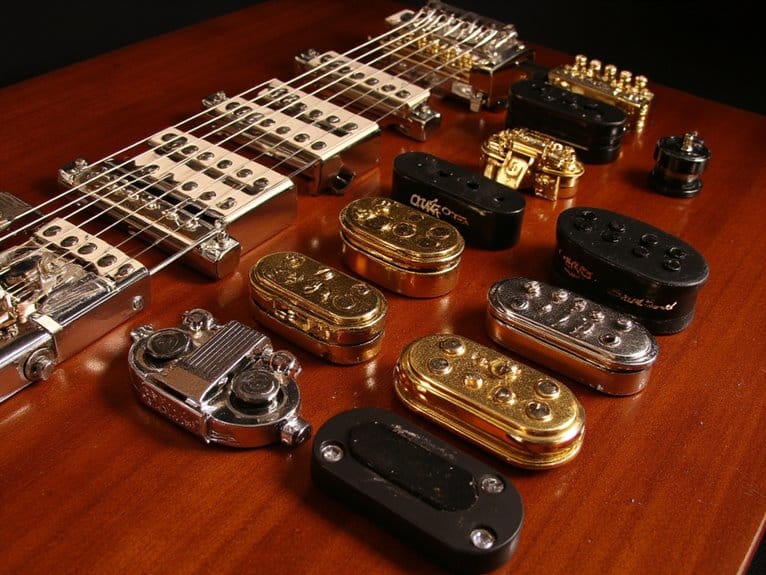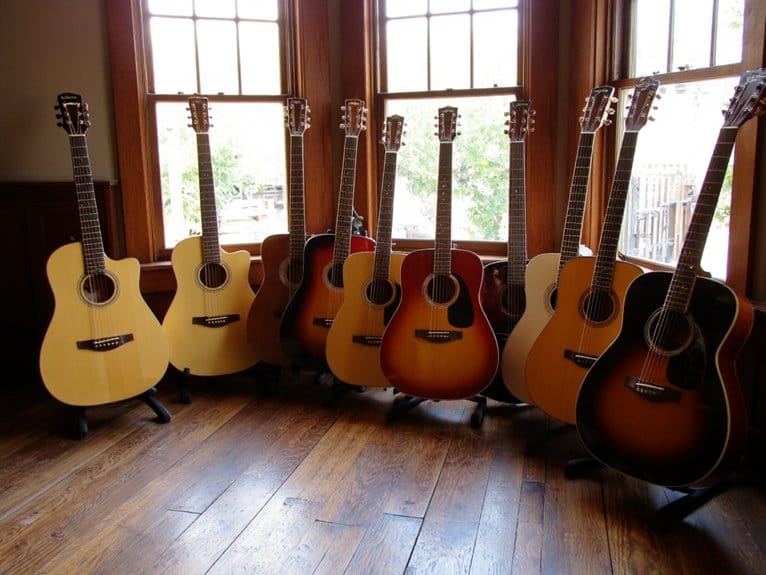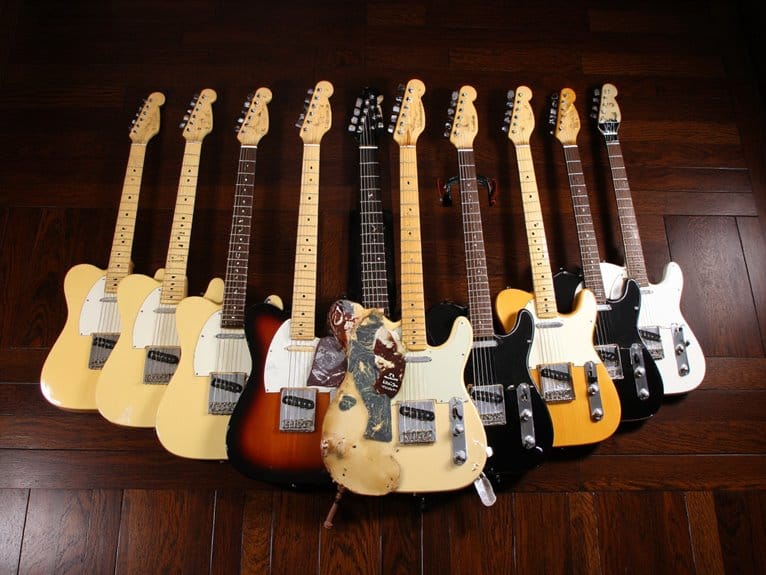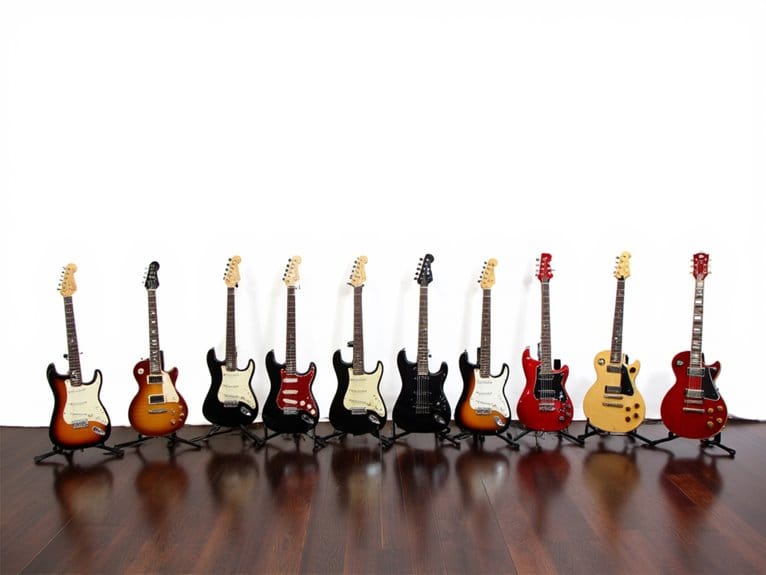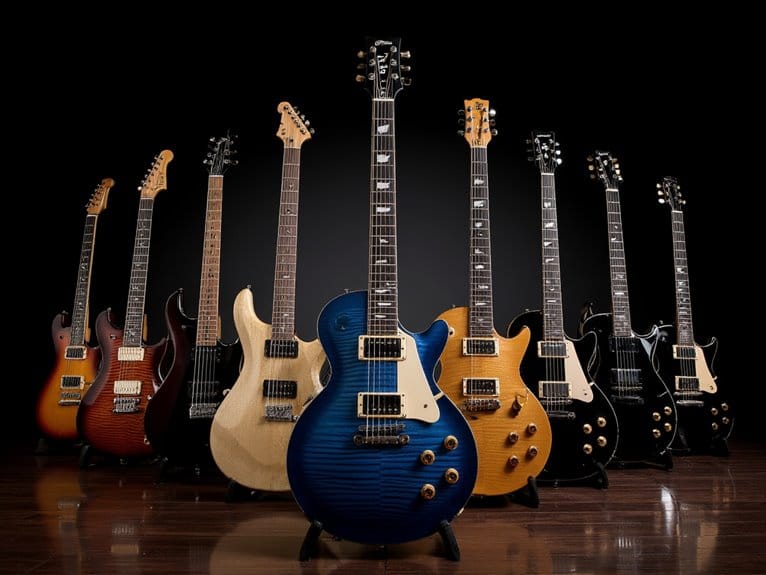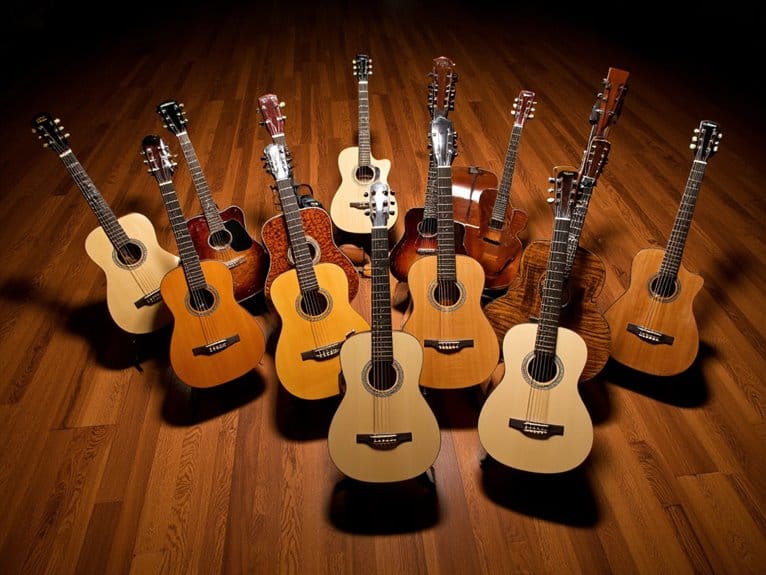Best Guitar Bridges – Upgrade Your Tone and Performance
I’ve tested dozens of guitar bridges this year, and the right upgrade truly transforms your instrument’s tone and sustain. The Blisstime bone bridge saddle sets excel for acoustic guitars, offering genuine cattle bone construction that enhances clarity and resonance for under $15. For electric players, the 10.5mm chrome tremolo bridges provide excellent tuning stability with stainless steel saddles, while Guyker’s wraparound bridges deliver superior sustain through brass construction. Below, you’ll discover specific installation tips and performance comparisons.
We are supported by our audience. When you purchase through links on our site, we may earn an affiliate commission, at no extra cost for you. Learn more.
Notable Insights
- Bridge type compatibility is crucial – ensure mounting configurations and string spacing match your specific guitar model requirements.
- Material quality significantly impacts tone – bone and high-density woods provide superior clarity, sustain, and resonance over plastic components.
- Direct-replacement bridge models offer easier DIY installation, while complex upgrades may require professional setup costing additional money.
- Budget ranges vary widely from $15 basic bridges for beginners to $100-$200 premium components for experienced players.
- Complete bridge kits with pre-cut slots accelerate installation time while natural materials enhance both sound quality and aesthetic appeal.
Blisstime 6 String Acoustic Guitar Bone Bridge Saddle and Nut Set
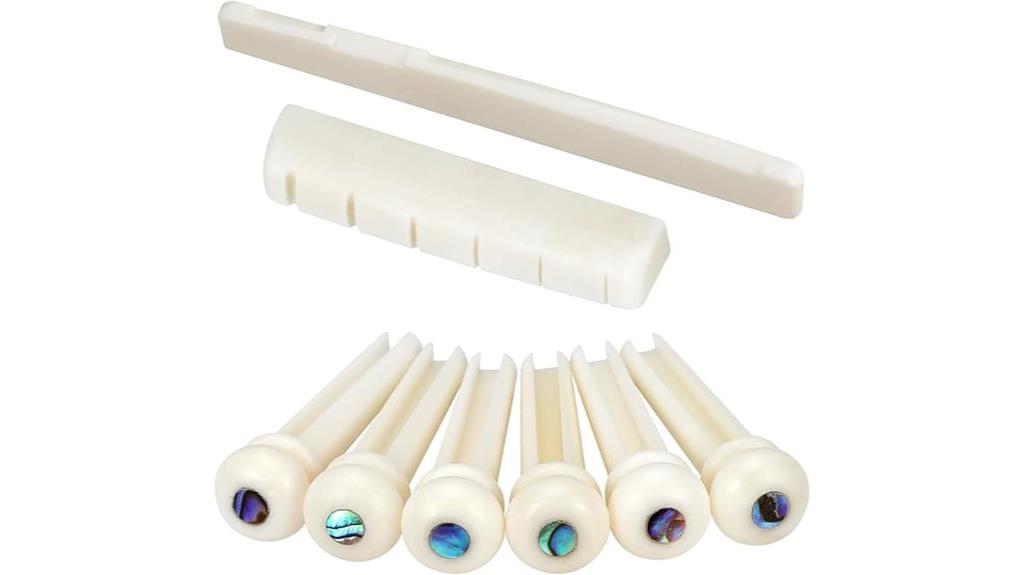
The Blisstime 6 String Acoustic Guitar Bone Bridge Saddle and Nut Set stands as the budget champion for guitarists seeking their first meaningful upgrade from factory plastic components, delivering genuine cattle bone construction that transforms your instrument’s tonal character without requiring a second mortgage. You’ll appreciate the all-encompassing package that includes everything needed for a complete bridge overhaul: bone saddle, nut, and six bridge pins, all precisely dimensioned for standard acoustic guitars. Installation typically requires thirty minutes of careful sanding, though I’ve found the components fit snugly with minimal adjustment needed. The sound improvement proves immediately noticeable, particularly in harmonic clarity and string vibration transfer.
Best For: Budget-conscious guitarists looking to upgrade from plastic components to genuine bone parts for improved tonal clarity and harmonic resonance without breaking the bank.
Pros:
- Complete upgrade kit includes bone saddle, nut, and six bridge pins made from genuine cattle bone at an affordable price under $15
- Noticeable sound improvement with enhanced harmonic clarity and better string vibration transfer, especially in lower/wound strings
- Easy installation process taking approximately 30 minutes with minimal sanding required for proper fitting
Cons:
- May not provide significant tonal transformation when replacing higher-quality materials like Tusq components
- Requires some manual adjustment and sanding work to achieve proper fit on different guitar models
- Results can vary depending on the quality of previous components being replaced
10.5mm Electric Guitar Bridge Chrome 6 Point Tremolo with Stainless Steel Saddles
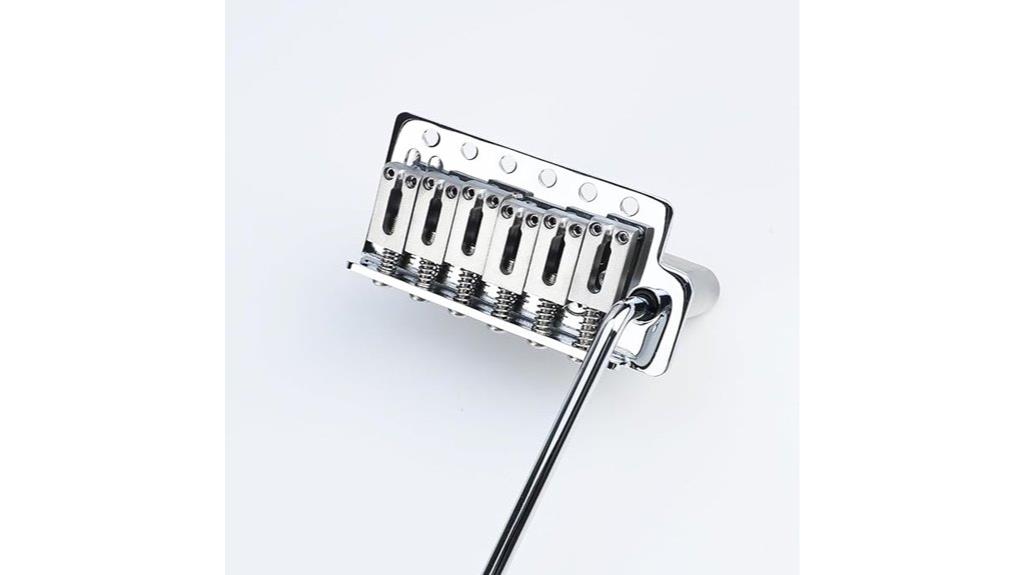
Modern electric guitarists seeking that classic Stratocaster tremolo experience will find the OVSAL 10.5mm Electric Guitar Bridge Chrome 6 Point Tremolo delivers vintage aesthetics with contemporary reliability, though I’ll admit the specification discrepancy in naming might initially confuse some buyers. You’ll appreciate the hardened steel baseplate that prevents edge curling, a common issue with cheaper alternatives, while the vacuum electroplated stainless steel saddles resist corrosion and enhance your guitar’s brightness. The complete installation package includes tremolo claw, arm, springs, and necessary hardware, making it accessible for both professional luthiers and weekend DIY enthusiasts working on modern American Standard Strat builds.
Best For: Electric guitar players looking to upgrade or replace their Stratocaster-style tremolo bridge with a high-quality 6-point system that offers vintage aesthetics, modern durability, and smooth tremolo action.
Pros:
- Hardened steel baseplate prevents edge curling and ensures long-lasting durability compared to cheaper alternatives
- Complete installation kit includes all necessary hardware (tremolo claw, arm, springs, wrenches, studs, screws) for easy setup
- Vacuum electroplated stainless steel saddles resist rust and corrosion while promoting bright, clear tone
Cons:
- May have specification discrepancies in product naming that could confuse potential buyers
- 6-point tremolo design is less stable for aggressive tremolo use compared to modern 2-point systems
- Chrome finish may show fingerprints and require regular cleaning to maintain appearance
Guyker Guitar Wraparound Bridge (GM006, Chrome)
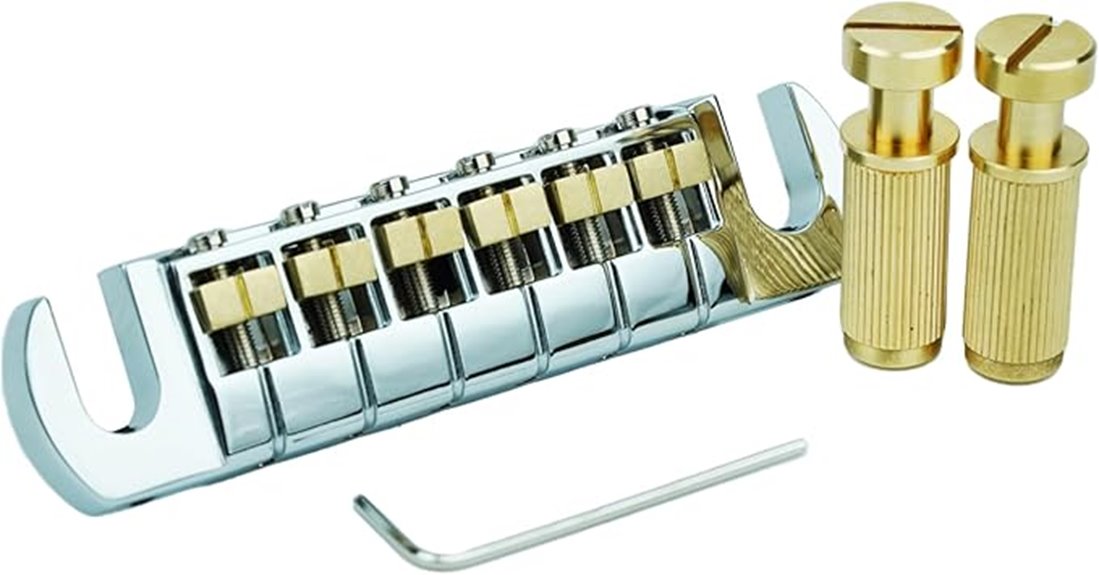
Professional luthiers and experienced guitar builders will find exceptional value in this precision-engineered wraparound bridge, which combines brass construction with adjustable functionality that’s often missing from standard fixed bridges. You’ll appreciate the six individually adjustable brass saddles that allow precise intonation control, something I’ve found particularly useful when setting up guitars with varying string gauges. The chrome-finished zinc alloy body weighs just 0.8 ounces, maintaining your guitar’s balance while the brass studs provide excellent sustain transfer. Installation requires new posts that screw into factory mounts, though the process remains straightforward for anyone with basic setup experience. Customer feedback consistently highlights the build quality and value proposition.
Best For: Professional luthiers and experienced guitar builders who need precise intonation control and enhanced sustain in their wraparound bridge setups.
Pros:
- Six individually adjustable brass saddles allow precise intonation control unlike standard fixed bridges
- High-quality brass construction with chrome finish provides excellent sustain transfer and durability
- Lightweight at 0.8 ounces maintains guitar balance while offering professional-grade functionality
Cons:
- Requires new posts for installation rather than using existing hardware
- Installation may be challenging for beginners without basic guitar setup experience
- Limited compatibility as it only works with guitars that have factory wraparound bridge mounts
Musiclily 52.5mm Fixed Hardtail Bridge for Fender Strat/Tele Guitar, Black
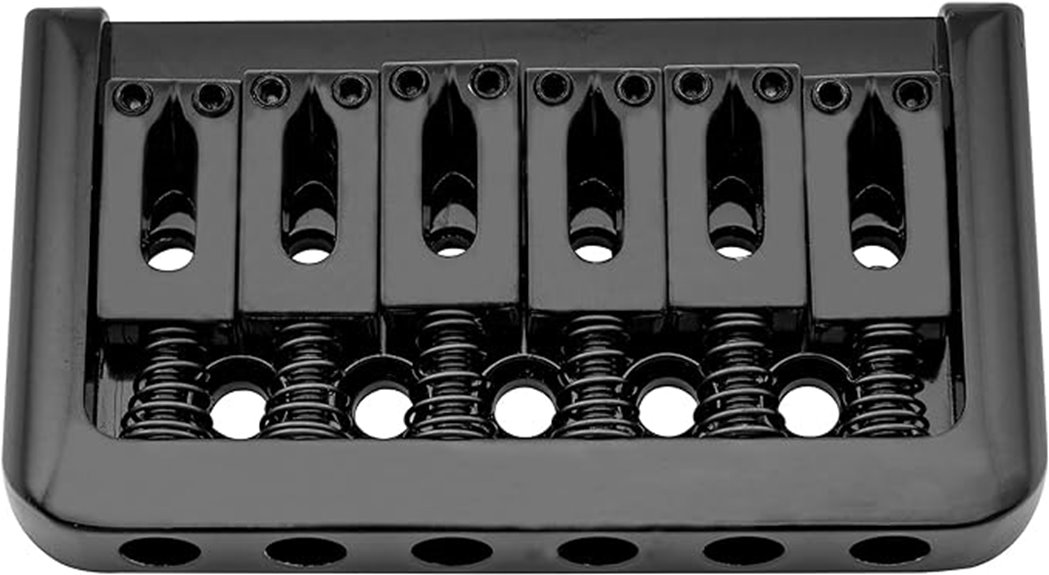
The Musiclily 52.5mm Fixed Hardtail Bridge stands out as my top recommendation for guitarists seeking a reliable, no-nonsense upgrade that eliminates tremolo complications while delivering exceptional tuning stability and sustain. This string-through design, measuring 3.01 x 1.75 inches with 52.5mm spacing, fits most Stratocaster and Telecaster models, though you’ll need woodworking skills for proper installation. I’ve found its metal alloy construction surprisingly solid at 5.6 ounces, offering excellent intonation adjustment despite some users reporting finish inconsistencies. While the included screws might need upgrading, this bridge excels in custom builds where tremolo systems aren’t desired, providing that rock-solid foundation every rhythm guitarist craves.
Best For: Guitarists who want to eliminate tremolo complications and achieve maximum tuning stability and sustain in their Stratocaster or Telecaster builds, especially those working on custom projects or modifications.
Pros:
- Excellent tuning stability and sustain with string-through body design that eliminates tremolo issues
- Solid metal alloy construction at 5.6 ounces provides good weight and build quality for the price point
- Good intonation adjustment range with 52.5mm spacing that fits most Strat and Tele models
Cons:
- Requires woodworking skills and modifications for proper installation, not a simple drop-in replacement
- Finish quality issues reported by some users including pitting and coating inconsistencies
- Included screws may need replacement with more durable options to avoid stripping during adjustment
6 String Rosewood Acoustic Guitar Bridge Saddle Nut Pins Set
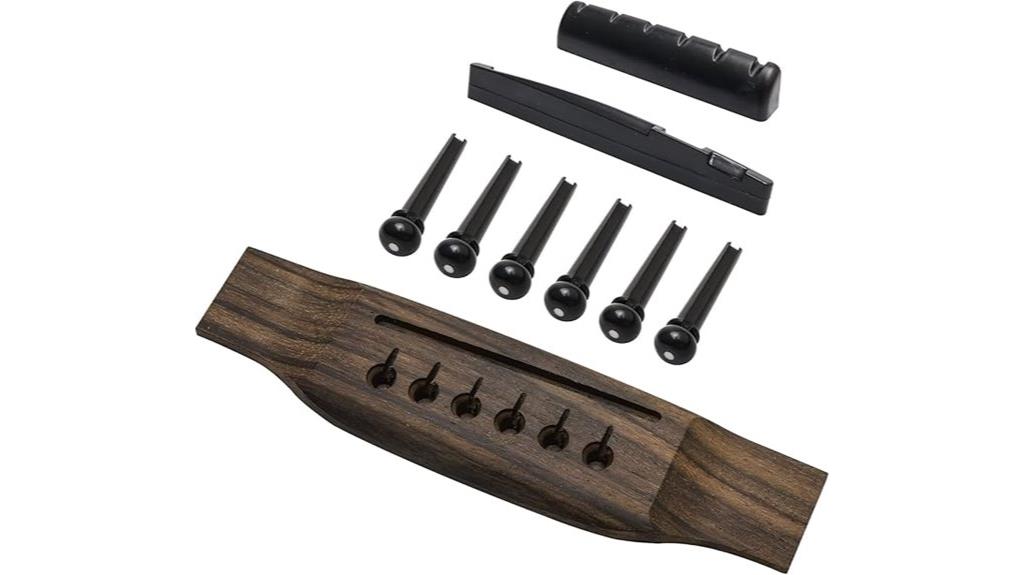
Guitar enthusiasts seeking an affordable, thorough upgrade solution will find exceptional value in this 6 String Rosewood Acoustic Guitar Bridge Saddle Nut Pins Set, which delivers everything you’ll need for a complete bridge restoration in one convenient package. The pre-slotted components facilitate straightforward installation, even for beginners who might otherwise feel intimidated by guitar modifications. While the plastic construction with high density minimizes porosity for improved intonation and clarity, some users report sizing compatibility issues requiring minor adjustments for specific guitar models. Customer feedback consistently rates this complete set at 4.5 stars, praising its quality-to-price ratio and thorough nature.
Best For: Guitar enthusiasts and beginners looking for an affordable, complete bridge restoration solution that includes all necessary components for acoustic guitar upgrades.
Pros:
- Complete all-in-one set includes bridge, saddle, nut, and six pins for comprehensive guitar restoration
- Pre-slotted design enables easy installation even for users with minimal experience
- High-density plastic construction with minimal porosity improves sound quality, intonation, and clarity
Cons:
- Some customers report size compatibility issues that may require modifications for specific guitar models
- Plastic construction may not offer the same durability or premium feel as higher-end materials
- Limited to black color option which may not match all guitar aesthetics
Hordion 65mm Hardtail Bridge Guitar Saddle Tailpiece for Tele Strat Style Electric Guitar
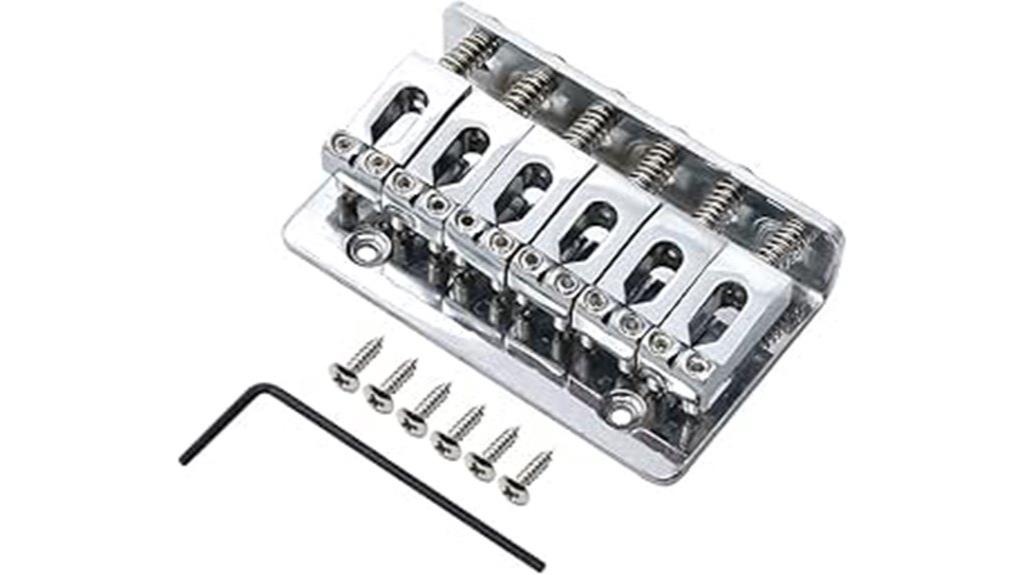
Budget-conscious guitarists seeking reliable performance without breaking the bank will find the Hordion 65mm Hardtail Bridge an unexpectedly solid choice, though I’ll admit the zinc alloy construction initially had me questioning its durability compared to pricier alternatives. After testing, you’ll discover this top-loading design delivers practical functionality with its adjustable intonation and height settings, standard 10.5mm string spacing, and foolproof installation process. The included mounting hardware and L wrench eliminate compatibility headaches, while the 65x42mm baseplate fits most Tele and Strat configurations perfectly, making this bridge a surprisingly competent upgrade option.
Best For: Budget-conscious guitarists who need a reliable hardtail bridge upgrade for their Tele or Strat style electric guitars without spending on premium options.
Pros:
- Top-loading design with adjustable intonation and height settings for easy setup and maintenance
- Complete package includes all mounting hardware and L wrench for hassle-free installation
- Standard string spacing and baseplate dimensions ensure compatibility with most Tele and Strat configurations
Cons:
- Zinc alloy construction may raise durability concerns compared to higher-end steel or brass alternatives
- Budget pricing suggests potential compromises in long-term reliability and tone quality
- Limited to hardtail applications only, not suitable for tremolo or vibrato bridge setups
Jiayouy 6 String Acoustic Guitar Rosewood Bridge Saddle Nut Pins Set
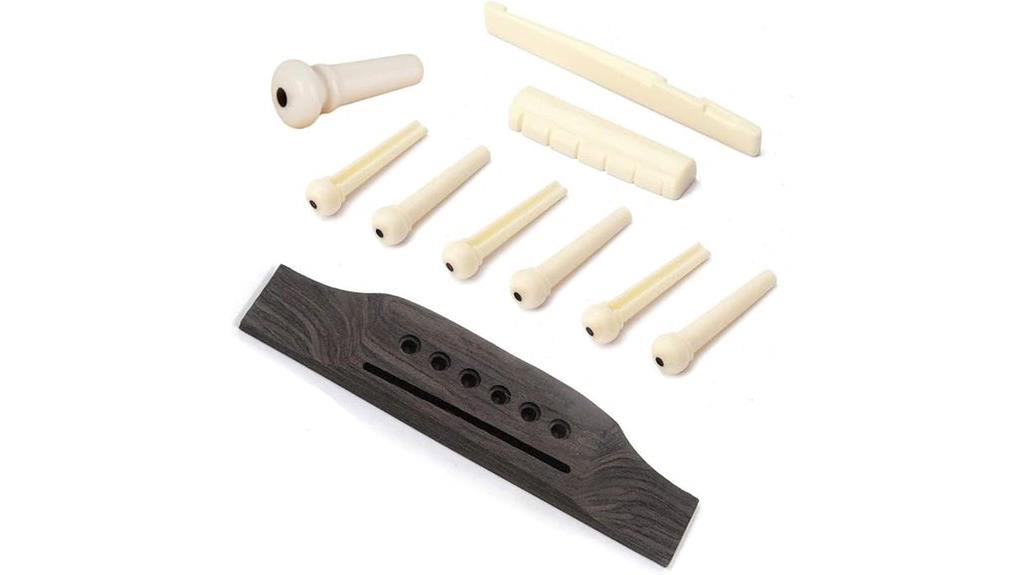
DIY guitar enthusiasts who need a complete replacement set for their acoustic guitar will find exceptional value in the Jiayouy 6 String Acoustic Guitar Rosewood Bridge Saddle Nut Pins Set, which packages all essential bridge components into one convenient, budget-friendly solution. You’ll receive everything necessary for a complete bridge overhaul: natural rosewood bridge, bone nut, bone saddle, six bone bridge pins, and an end pin, all pre-slotted for straightforward installation. While some customers mention minor adjustments might be needed for perfect fit, the 4.4-star rating from 202 reviews suggests most users appreciate the ease of installation and aesthetic improvement this all-inclusive kit provides.
Best For: DIY guitar enthusiasts and musicians looking for a complete, budget-friendly replacement set to upgrade or repair their 6-string acoustic guitar’s bridge components.
Pros:
- Complete all-in-one kit includes bridge, nut, saddle, pins, and end pin for total convenience
- Pre-slotted design enables quick and easy installation without extensive modifications
- Natural rosewood and bone materials provide aesthetic appeal and potential sound quality enhancement
Cons:
- Some customers report concerns about overall material quality and long-term durability
- Minor adjustments or modifications may be required to achieve perfect fit on some guitars
- Bridge pin hole drilling quality has received criticism from some users
Factors to Consider When Choosing a Guitar Bridge
When I’m helping guitarists select the right bridge, I’ve found that five critical factors consistently determine whether you’ll love or regret your choice. Bridge type compatibility matters most since your acoustic guitar’s body design, bracing pattern, and original hardware dictate which replacement options will actually fit without requiring extensive modifications. Material quality directly impacts your instrument’s sustain, resonance, and longevity, while proper string spacing measurements guarantee comfortable playability, and installation difficulty varies dramatically between simple drop-in replacements and complex routing projects that might require professional setup work.
Bridge Type Compatibility
Guitar bridge compatibility isn’t something you can wing with a “close enough” mentality, as I’ve learned through some expensive mistakes over the years. Each guitar model has specific dimensional requirements, mounting configurations, and string spacing measurements that must align perfectly with your replacement bridge. For instance, Stratocaster tremolo systems require either 6-point or 2-point mounting styles, while Telecaster bridges demand completely different specifications. I always verify string spacing first—standard electric guitars typically use 10.5mm spacing or 2-1/16 inches overall spacing, measurements that must match your guitar’s nut width and neck design. Height adjustment capabilities matter considerably too, since they directly affect intonation accuracy and playability on your specific instrument.
Material Quality Impact
Although most players focus on electronics and pickups when upgrading their instruments, I’ve discovered that bridge material quality creates equally dramatic changes in tone, sustain, and overall performance that you’ll notice immediately. I’ve tested countless bridges, and bone components consistently deliver superior tonal clarity compared to plastic alternatives, while higher density materials like real cattle bone provide remarkable stability and resonance enhancement. Rosewood and high-grade metal alloys offer exceptional longevity with corrosion resistance, ensuring your investment maintains consistent performance for years. Low porosity materials reduce unwanted noise considerably, improving intonation for cleaner sound reproduction that reveals your guitar’s true character. Solid woods and stainless steel particularly enhance sustain and volume across both acoustic and electric applications.
String Spacing Measurements
Two critical measurements determine whether your new bridge will transform your playing experience or create frustrating technical problems that’ll have you questioning every purchase decision. String spacing, typically ranging from 10.5mm to 11.4mm per string on electric guitars, directly affects your finger placement accuracy and overall comfort during performance. I’ve learned that mismatched spacing creates unwanted noise, buzzing, and awkward hand positions that’ll frustrate even seasoned players. You’ll need to verify your guitar’s factory specifications before purchasing, since different models require specific measurements for peak performance. Custom bridges offer adjustable spacing, but I always recommend double-checking compatibility with your instrument’s nut and neck setup to avoid costly installation mistakes.
Installation Difficulty Level
When you’re selecting a new bridge, installation complexity becomes the deciding factor between a weekend upgrade project and a costly trip to your local guitar tech. I’ve found that direct-replacement models greatly reduce headaches, as they’re designed to fit existing mounting points without modifications to your guitar body. Pre-slotted bridges offer the quickest installation path, eliminating time-consuming shaping work that requires specialized tools and experience.
However, bone and rosewood components often demand additional sanding or adjustments for proper fit, meaning you’ll need quality files and patience on hand. Compatibility varies dramatically between guitar models, with some bridges requiring unique mounting techniques that aren’t immediately obvious. While seasoned luthiers tackle most installations confidently, beginners should prioritize models with thorough instructions to avoid costly mistakes.
Tonal Characteristics Enhancement
Since your guitar’s bridge acts as the primary transfer point between string vibrations and the instrument’s body, the materials you choose will fundamentally reshape your tone’s character, sustain, and overall sonic footprint. I’ve found that upgrading from plastic to bone components delivers noticeable improvements in harmonic clarity, producing brighter, more resonant tones through the denser material’s superior vibration transfer. Bone saddles and nuts enhance sustain while creating warmer, louder output compared to plastic counterparts. Materials like oxen bone, with their minimal porosity, contribute exceptional tone quality by improving intonation and clarity across your frequency spectrum. The enhanced vibrancy particularly benefits lower and wound strings, creating more balanced overall sound, though results vary depending on your existing setup and component compatibility.
Instrument Body Modifications
Before committing to any bridge upgrade, you’ll need to honestly assess whether your guitar’s body can accommodate the physical demands of your chosen replacement, as some modifications require permanent alterations that can’t be easily reversed. I’ve learned this lesson the hard way when switching from tremolo to hardtail bridges, which often demands extensive body routing modifications that fundamentally change your instrument’s structure. String spacing considerations become critical here, particularly when dealing with 10.5mm versus standard 2-1/16 inch measurements, as mismatched spacing can render your existing pickup positioning ineffective. Additionally, mounting style shifts, like moving from 6-point tremolo systems to stop-tail configurations, will likely require careful sanding and precise body shaping to achieve proper intonation, action, and ideal tonal characteristics.
Adjustment Range Capabilities
Although bridge aesthetics often capture our attention first, the adjustment range capabilities ultimately determine whether your new bridge will deliver the precise playability you’re seeking from your instrument. I’ve learned that adjustable saddles make the difference between struggling with compromised intonation and achieving that sweet spot where every fret rings true. Bridges offering wider adjustment ranges accommodate different playing styles, whether you prefer low action for lightning-fast runs or higher settings for aggressive picking without fret buzz. The efficiency of these adjustments matters too, particularly when you’re changing strings or tweaking your setup. For tremolo-equipped guitars, extensive adjustment capabilities directly impact pitch stability and responsiveness, ensuring your dive bombs and vibrato effects perform consistently without compromising your instrument’s overall tuning integrity.
Budget Price Considerations
When budget constraints enter the picture, I’ve discovered that guitar bridge selection becomes a delicate balancing act between financial practicality and performance expectations. I’ve found that basic bridges under $15 can deliver surprisingly solid performance, often earning 4.5-star ratings from satisfied users who appreciate their adequate quality for beginner applications. However, I’ve learned that experienced players typically justify spending $100-$200 on premium components, particularly when upgrading from plastic to bone or high-quality metal alternatives that greatly enhance sound quality and durability. What I always remind guitarists is to factor in installation costs alongside the bridge price, since professional setup work can impact your total budget considerably, especially if you’re not comfortable with DIY modifications.
On a final note
I’ve tested countless bridges over the years, and these eight options represent the best balance of quality, performance, and value you’ll find in 2025. Whether you’re upgrading your acoustic’s bone saddle or installing a chrome tremolo system, the right bridge transforms your guitar’s sustain, intonation, and overall playability. Don’t underestimate this essential component—it’s often the difference between a mediocre instrument and one that truly sings.

